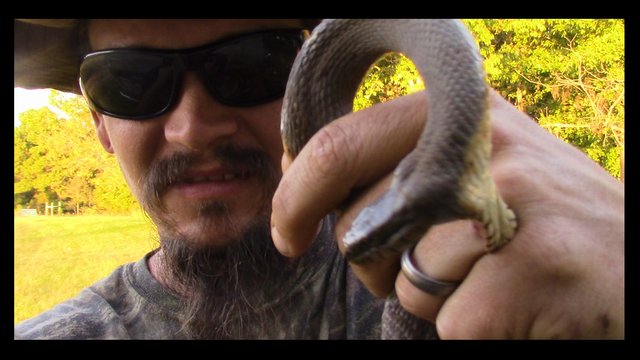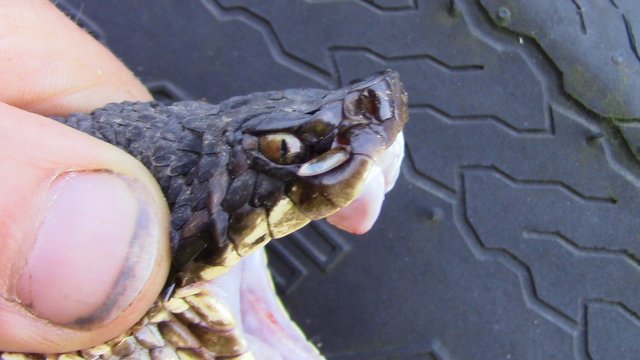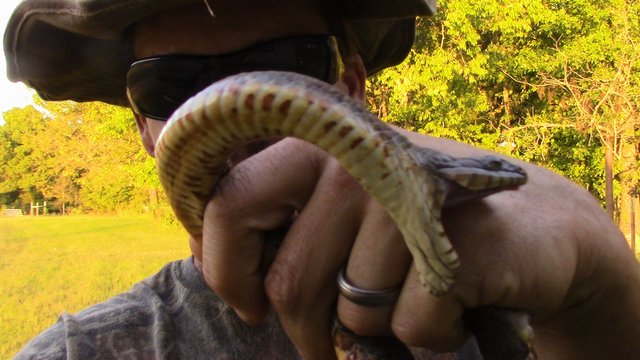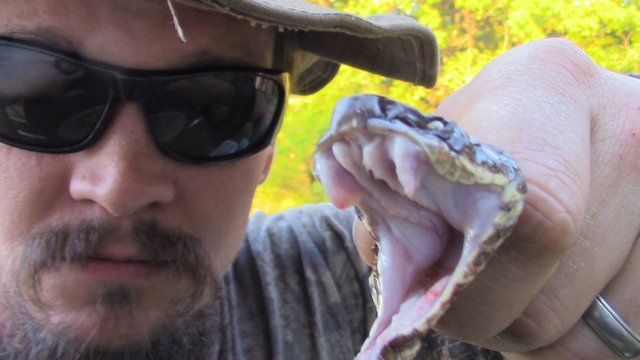HOW TO ACCURATELY IDENTIFY A WATER MOCCASIN

The accurate identification of venomous species of snakes can be important!
Do you see that snake biting me in the hand in the cover photo? That is a nonvenomous Northern Water Snake. Since they live in and near water, they are often misidentified as Water Moccasins and needlessly killed. In this video, I first familiarize you with the Northern Water Snake as an example of a nonvenomous snake that is common to see near the water and then show you the differences that the venomous pit viper known as the Water Moccasin or Cottonmouth has.

A FEW DIFFERENCES
Water Moccasins are a particular kind of venomous snake in the pit viper family. In the United States, pit vipers include that Water Moccasin (AKA Cottonmouth), the Copperhead, and Rattlesnakes. With these pit vipers, you will find some common characteristics.

In this close up photo of the Water Moccasin, you can see that it has an elongated pupil. If a snake has round pupils, that does not mean it is nonvenomous. The Coral Snake is a venomous snake in the United States that has round pupils. Having round pupils for snakes in the United States just means that they are not pit vipers. Rattlesnakes, Copperheads and Water Moccasins will all have the elongated pupils.
Additionally, pit vipers like this Cottonmouth will have heat pits. Heat pits can be noticed because there are small holes between the eyes and the nostrils of pit vipers. With these sensitive organs, put vipers can sense heat, which can help them locate warmblooded mammals to prey upon.
The fangs are also a good giveaway that a snake is venomous, but not all venomous will have visible fangs or display them. Though Water Moccasins will open their mouths as a defense mechanism, they will not always display their fangs. The large, gaping white mouth is a good sign that the snake is a Cottonmouth, and it is where the Water Moccasin gets its nickname from.
In the video, I also show how the belly pattern is different, and the difference in belly scales. The opening in the belly scales where snakes defecate and reproduce from is called a vent. Many snakes will have single belly scales before the vent and double belly scales after the vent. Double belly scales means that there are two scales, one coming form each side, which meet int he middle. Pit vipers, like the Moccasin, continue to have single belly scales after the vent.
Yes, I know that many people will never grab a snake by the tail when it is in the bushes and peek underneath to see what kind of scales it has after the vent, but I certainly have.

It is worth mentioning that even bites from nonvenomous snakes can be dangerous and the wounds could become infected, but for the most part, there are only two ways to get but by any snake.
The first way is by accident. This can and does happen, and when it does occur it is often when a human comes close to a snake without knowing that it is there. The snake sees the human as a threat and strikes in defense.
The second way that most people end up getting bit is when they are trying to kill or capture them. The safest way to reduce your risk of being bit by a snake is to not try to kill or handle them. It is unfortunate that many people have an unrealistic fear of snakes and think that snakes are going to attack people. Then, when they see a snake, they attack it try to prevent it from hurting anyone and get bit in the process. When this happens, they claim, "See I told you it was dangerous."
Though there are some snakes in the world that will follow or come at a person, this is rarely the case with many species. With the varieties I have dealt with, I have never once been chased by a snake. The hundreds of snakes that I have caught were always ones that I had to chase. It would be easier if they would just chase me.
Anyway, as with any wild animals, their place is in the wild, and if we know how to accurately identify them, it can help keep us, and them, safe. I hope that you enjoyed the video!

COPPERHEAD HOW TO TOO!
If you enjoyed this video, you may also be interested in my How to Accurately Identify a Copperhead Snake video from four months ago. Since they are both pit vipers, some of the info is similar, but it is another venomous snake that lives where many of us live, so it may be a good idea to know how to accurately identify one. Enjoy!

As always, I'm @papa-pepper and here's the proof:

proof-of-water-moccasin
Until next time…
Don’t waste your time online, invest it with steemit.com


Great identification post, had these everywhere when I lived in the swamp.
Should add that while you should still get to a hospital, moccasin venom is rarely lethal to adults. My family got rid of them because of pets and kids but it may help some people not feel a need to kill.
Right, that is a very good point. I'll upvote your comment so more can read that part!
Thank you very much : ) glad I was able to add something.
Thank you for adding it!
I do not understand anything about snakes,
because basically I am afraid of snakes,
but I am interested about the videos and articles, because it can increase knowledge about snakes,
at first glance this snake appears harmless, if you disposed to guided me, I also want to hold it..
Thank for sharing @papa-pepper 😊
What got your interest in snakes started! You certainly know a lot about them! My son had a pet snake once. That is the only one I got close to on a voluntary basis.
But I had a boa or python come into my store once and then hide in the water melon bin. An animal control guy happened to drive down the street and we flagged him down. He had it caught in no time and our customers could stop freaking out. It was kind of funny since it certainly was someone's pet and they are not poisonous, but I was glad that the situation got resolved quickly.
I freak out sighting snakes.
I like just about all animals, we just happen to have a lot of snakes here.
Great works, I wish you success
wow Amazing post
Its very important to have knowledge about any animals before killing..Unknowingly many times we kill nonvanomouse snakes.
Agreed, but if you don't know, always better to play it safe (imo)
Yes
I've heard about the identification by eye type. Glad to see it again in more details. Thanks.
Yeah, not a foolproof way to determine whether a snake is venomous or not, so people need to be careful and hear the full story behind it.
I agree. You have to know what you are doing to be able to pull it off.
Hmmm, thanks for the free lecture @papa-pepper! :)
LOL - Thanks!
😵😵😵😵
Forwarding to... the entire state of Florida! They got gators and water moccasins in the streets right now!
Great works, I wish you success